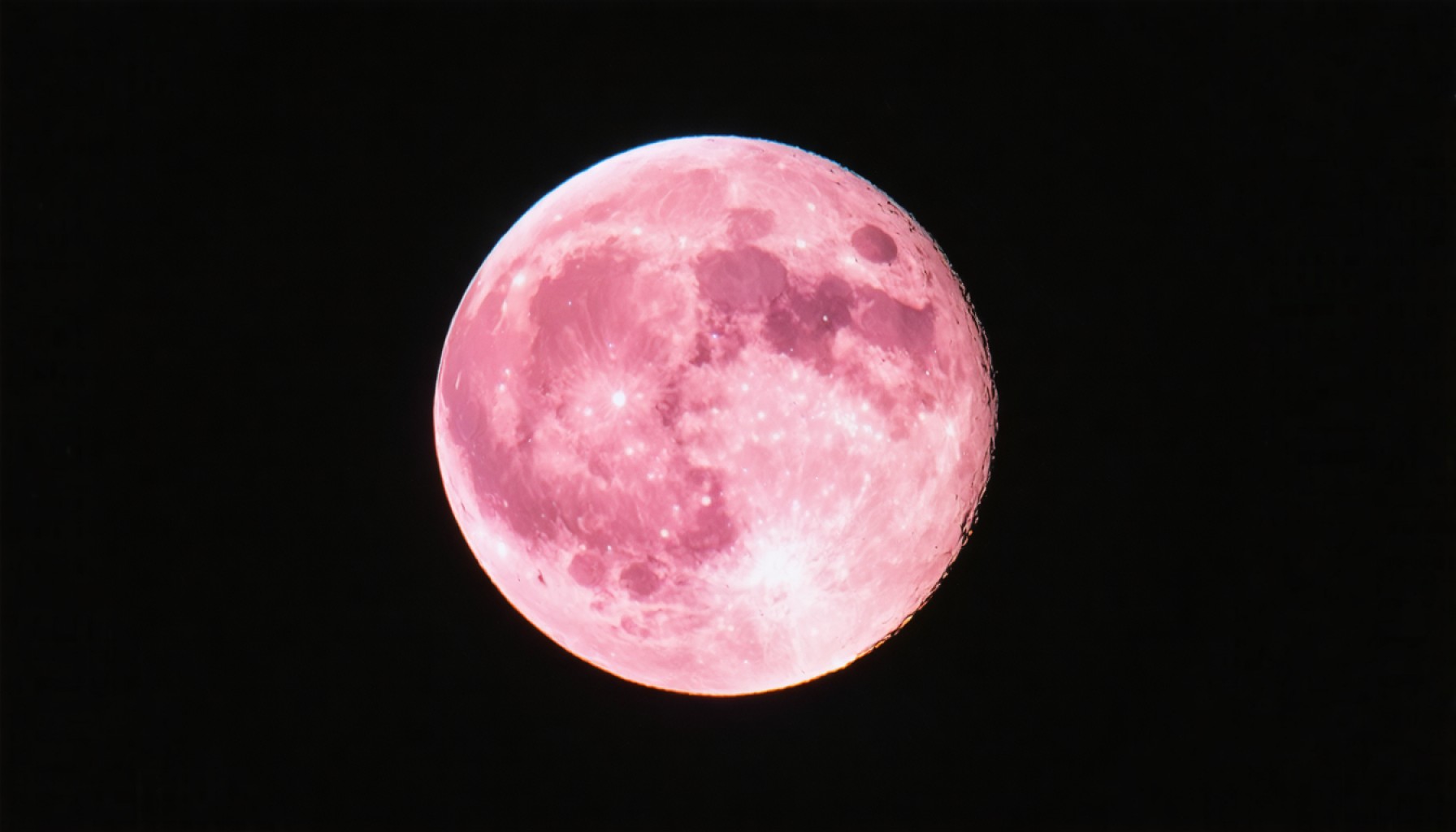- The “Pink Moon” reaches its zenith at 8:22 PM ET on a Saturday, despite its name, it won’t appear pink but heralds the arrival of spring wildflowers.
- This year’s Pink Moon is a “Micromoon,” appearing smaller due to its distance from Earth, adding a delicate charm to the night sky.
- Known as the “Paschal Moon,” it has cultural and spiritual significance, influencing the date of Easter.
- For optimal viewing, choose locations away from urban light pollution, such as open fields or hilltops.
- The moon will be near Spica in the Virgo constellation, with celestial guidance provided by the arc of the Big Dipper’s handle.
- Stargazers in Central and South America may experience an occultation, where the moon momentarily covers Spica.
- The event encourages reflection on the universe’s wonders, offering solace from everyday life’s demands.
April’s night sky is about to unveil a celestial spectacle that invites sky watchers across the globe to pause and gaze eastward. Aptly named the “Pink Moon,” this full moon will reach its zenith at 8:22 PM ET on Saturday. Despite its name, this moon won’t be donning a rosy hue. The “Pink” moniker is a nod not to its color but rather to the vivid pink wildflowers, particularly the Creeping Phlox, that herald spring’s arrival.
Unique among its lunar peers this year, the Pink Moon earns the title of “Micromoon.” Unlike its larger counterpart, the “Supermoon,” this phenomenon occurs when the moon is at its farthest orbital point from Earth, rendering it slightly smaller in appearance. Its subtlety only magnifies its allure, as it hovers like a painter’s touch across the canvas of the nocturnal sky.
This full moon carries profound cultural and spiritual significance, often referred to as the “Paschal Moon.” In the Christian tradition, it plays a pivotal role in determining the date of Easter, which this year falls on April 20. This connection to ancient customs and timing weaves a rich tapestry of human history into the night sky.
For the eager observer, the Pink Micromoon offers an opportunity not just to watch, but to experience. Ideal viewing conditions suggest a vantage point free from urban light pollution. Whether you’re standing in an open field, atop a windswept hill, or beside the gentle ebb of a beach, each setting offers its own unique frame for the cosmic display.
Guiding the eye, the moon will accompany Spica, the resplendent jewel of the constellation Virgo, shimmering close by in the night’s expanse. Utilizing celestial markers like the arc of the Big Dipper’s handle can lead eyes from the radiant Arcturus to Spica’s eastern glow. Some lucky stargazers across Central and South America may witness a rare event where the moon momentarily obscures Spica, an astronomical dance known as an “occultation,” visible in cities like Buenos Aires and Montevideo.
This celestial event invites us all to step outside and immerse ourselves in the majesty and wonder of the universe. Even as we grapple with the hustle of daily life, the Pink Moon offers a reminder of the timeless beauty of the world above us—a gentle nudge to look up and find solace in the stars.
Experience the Majestic Pink Micromoon: A Celestial Journey Awaiting You!
As the Pink Moon graces the night sky, enthusiasts and casual observers alike have a chance to delve into its allure beyond just its aesthetic appeal. Although the Pink Moon doesn’t truly appear pink, its name commemorates the spring bloom of vibrant Creeping Phlox flowers. This year, its status as a “Micromoon,” due to its distant orbital position, adds an additional layer of intrigue, making it appear slightly smaller than usual.
Cultural and Historical Significance
The Pink Moon, often known as the “Paschal Moon,” holds deep spiritual and cultural meaning. Historically, it serves as a key indicator in the Christian tradition to determine the date of Easter, anchoring this celestial event within a broader tapestry of human customs and rituals.
How to Best Observe the Pink Micromoon
To capture the full beauty of the Pink Micromoon, follow these guides:
1. Find the Perfect Spot: Seek an area far from urban light pollution, such as a rural field or quiet beach, for the clearest view.
2. Timing Matters: The moon reaches its peak at 8:22 PM ET. Plan to be in your chosen location well before this time to get settled and adjust your eyes to the dark.
3. Bring the Right Gear: While no equipment is necessary, a pair of binoculars or a telescope can enhance your viewing experience.
4. Spot Celestial Neighbors: Use the Big Dipper’s handle to locate Arcturus, then continue towards the east to find Spica near the moon. Some may even witness the rare occultation of Spica by the moon.
Insights & Predictions
Astrophysicists and astronomers predict that while micromoons may lack the grandeur of supermoons, they offer a unique aesthetic value and an opportunity to explore the subtleties of our night sky. Future micromoons will continue to capture the public’s interest, highlighting the continuous relationship between humanity and celestial phenomena.
Security & Sustainability
The event also underscores the importance of preserving dark skies, free from the pollution of artificial light. Advocacy for reducing light pollution is crucial for the ongoing enjoyment and study of astronomical events.
Quick Tips for Immediate Application
– Create a Viewing Checklist: List essentials like warm clothing, snacks, and a comfortable chair.
– Use Technology: Apps like Stellarium or SkyView can help you track the moon’s movement and identify stars like Spica and Arcturus.
– Invite Friends: Share the experience with others to cultivate a communal appreciation of the night sky.
By taking the time to prepare and observe, the Pink Micromoon can transform from a distant spectacle into an intimate encounter with the cosmos, inviting moments of reflection and awe.
For more information on celestial events and astronomy, visit NASA.
